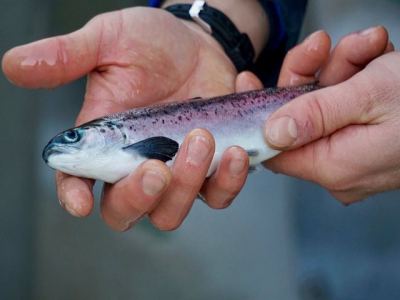First salmon smolts transferred from SSFs new RAS hatchery

The first smolts from Scottish Sea Farms’ new GBP 55 million (USD 72.3 million, EUR 65.3 million) Barcaldine Hatchery, located on the shores of Loch Creran, have been transferred to sea pens.
Photo courtesy of Scottish Sea Farms
Having arrived at the hatchery as eggs in January, the young salmon were hatched and reared using a recirculating aquaculture system (RAS) until they reached an average weight of 160 grams. This was more than double that of smolts grown by SSF when using traditional hatchery methods.
“This is a major milestone for all of the team, not just at Barcaldine but across the company. The new hatchery has given us greater control over key factors including water quality, oxygen levels, temperature, light and speed of flow, meaning we have been able to ensure the best growing environment for the salmon,” SSF Freshwater Manager Pål Tangvik said. “The result is bigger, more robust smolts that will be better able to withstand the natural challenges of the marine environment.”
Bigger smolts going into SSF’s net pens means that the fish will have to spend less time in the more hazardous environment.
“We will also be able to shorten the time these salmon will spend at sea by up to two months which will reduce their exposure to these challenges and increase survival rates, and have longer fallow periods between crops which will contribute towards a safer environment for subsequent generations of fish,” Tangvik said.
At the hatchery, incoming water is filtered to remove any particles, then disinfected using UV light. It is maintained at a constant temperature of between 12 and 14 degrees Celsius, before being cleaned again and recirculated every 20-30 minutes.
This process uses 98 percent less freshwater and significantly less energy compared with heating and cooling water at traditional hatcheries, the hatchery’s operations manager, Noelia Rodriguez, said.
“Adding to this, the building uses a biomass energy system – thought to deliver the biggest CO2 savings of any renewable heat source – to provide heating and hot water, and there is provision for a hydro scheme so that we can generate even more energy in a greener way,” she said.
The facility, which includes four incubation units and four hatcheries, has taken more than two years to build. It is due to have its official opening in 2020.
“We haven’t rushed the process. We’ve taken care to make sure we get it right at every stage. However the sheer scale of the investment being made – time, thought and money – signifies our commitment to fish health and to providing a more secure food supply,” SSF Managing Director Jim Gallagher said. “The RAS technology enables us to control with pinpoint accuracy when the salmon are ready to go to sea, giving the fish the best possible experience and giving customers the world-over more security over supply than ever before.”
Related news
 Research reveals new ways to raise EPA and DHA levels in both salmon and humans
Research reveals new ways to raise EPA and DHA levels in both salmon and humans Diets containing a mixture of plant oil and fish oil can stimulate both salmon and humans to produce their own long chain omega-3 fats
 Wild salmon pathogens discovered that could pose a threat to aquaculture
Wild salmon pathogens discovered that could pose a threat to aquaculture Three new viruses – including one type that has never previously infected fish – have been identified in populations of both wild and farmed salmon
 Salmon farmers sign up for algal alternative to fish oil
Salmon farmers sign up for algal alternative to fish oil A coalition of Norwegian fish farmers has formed a new partnership which will ensure that their feeds contain an algal ingredient that will help them improve